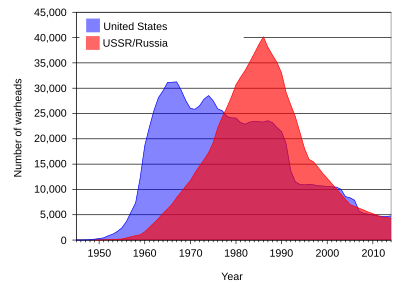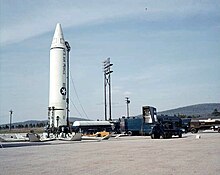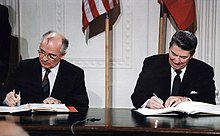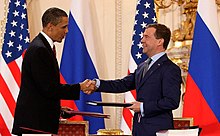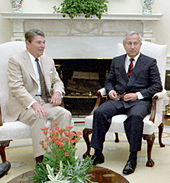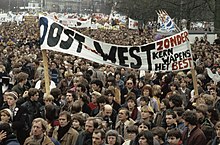United States and Soviet Union/Russia nuclear weapon stockpiles
The nuclear arms race was an arms race competition for supremacy in nuclear warfare between the United States, the Soviet Union, and their respective allies during the Cold War. During this period, in addition to the American and Soviet nuclear stockpiles, other countries developed nuclear weapons, though none engaged in warhead production on nearly the same scale as the two superpowers.
World War II
The first nuclear weapon was created by the United States of America during the Second World War and was developed to be used against the Axis powers. Scientists of the Soviet Union were aware of the potential of nuclear weapons and had also been conducting research on the field.
The Soviet Union was not informed officially of the Manhattan Project until Stalin was briefed at the Potsdam Conference on July 24, 1945, by U.S. President Harry S. Truman, eight days after the first successful test of a nuclear weapon.
Despite their wartime military alliance, the United States and Britain
had not trusted the Soviets enough to keep knowledge of the Manhattan
Project safe from German spies: there were also concerns that, as an
ally, the Soviet Union would request and expect to receive technical
details of the new weapon.
When President Truman informed Stalin of the weapons, he was
surprised at how calmly Stalin reacted to the news and thought that
Stalin had not understood what he had been told. Other members of the
United States and British delegations who closely observed the exchange
formed the same conclusion.
In fact Stalin had long been aware of the program,
despite the Manhattan Project having a secret classification so high
that, even as Vice President, Truman did not know about it or the
development of the weapons (Truman was not informed until shortly after
he became president). A ring of spies operating within the Manhattan Project, (including Klaus Fuchs and Theodore Hall) had kept Stalin well informed of American progress. They provided the Soviets with detailed designs of the implosion bomb and the hydrogen bomb.
Fuchs' arrest in 1950 led to the arrests of many other suspected
Russian spies, including Harry Gold, David Greenglass, and Ethel and
Julius Rosenberg.
In August 1945, on Truman's orders, two atomic bombs were dropped on Japanese cities. The first bomb was dropped on Hiroshima, and the second bomb was dropped on Nagasaki by the B-29 bombers named Enola Gay and Bockscar respectively.
Shortly after the end of the Second World War in 1945, the United Nations
was founded. During the United Nation's first General Assembly in
London in January 1946, they discussed the future of Nuclear Weapons and
created the United Nations Atomic Energy Commission.
The goal of this assembly was to eliminate the use of all Nuclear
weapons. The United States presented their solution, which was called
the Baruch Plan.
This plan proposed that there should be an international authority that
controls all dangerous atomic activities. The Soviet Union disagreed
with this proposal and rejected it. The Soviets' proposal involved
universal nuclear disarmament. Both the American and Soviet proposals
were refused by the UN.
Early Cold War
Warhead Development
In
the years immediately after the Second World War, the United States had
a monopoly on specific knowledge of and raw materials for nuclear
weaponry. American leaders hoped that their exclusive ownership of
nuclear weapons would be enough to draw concessions from the Soviet Union but this proved ineffective.
Just six months after the UN General Assembly, the United States conducted its first post-war nuclear tests. This was called Operation Crossroads. The purpose of this operation was to test the effectiveness of nuclear explosions on ships. These tests were performed at Bikini Atoll
in the Pacific on 95 ships, including German and Japanese ships that
were captured during World War II. One plutonium implosion-type bomb was
detonated over the fleet, while the other one was detonated underwater.
Behind the scenes, the Soviet government was working on building
its own atomic weapons. During the war, Soviet efforts had been limited
by a lack of uranium but new supplies in Eastern Europe
were found and provided a steady supply while the Soviets developed a
domestic source. While American experts had predicted that the Soviet
Union would not have nuclear weapons until the mid-1950s, the first
Soviet bomb was detonated on August 29, 1949, shocking the entire world.
The bomb, named "First Lightning" by the West, was more or less a copy of "Fat Man", one of the bombs the United States had dropped on Japan in 1945.
Both governments spent massive amounts to increase the quality
and quantity of their nuclear arsenals. Both nations quickly began the
development of a hydrogen bomb and the United States detonated the first hydrogen bomb on November 1, 1952, on Enewetak, an atoll in the Pacific Ocean.
Code-named "Ivy Mike", the project was led by Edward Teller, a
Hungarian-American nuclear physicist. It created a cloud 100 miles wide
and 25 miles high, killing all life on the surrounding islands.
Again, the Soviets surprised the world by exploding a deployable
thermonuclear device in August 1953 although it was not a true
multi-stage hydrogen bomb. However, it was small enough to be dropped
from an airplane, making it ready for use. The development of these two
Soviet bombs was greatly aided by the Russian spies Harry Gold and Klaus
Fuchs.
On March 1, 1954, the U.S. conducted the Castle Bravo test, which tested another hydrogen bomb on Bikini Atoll.
Scientists significantly underestimated the size of the bomb, thinking
it would yield 5 megatons. However, it yielded 14.8 megatons, which is
the largest nuclear explosion tested by the U.S. The explosion was so
large the nuclear fallout exposed residents up to 300 miles away to
significant amounts of radiation. They were eventually evacuated, but
most of them experienced radiation poisoning and resulted in one death
from a crew member of a fishing boat 90 miles from the explosion.
The Soviet Union detonated its first "true" hydrogen bomb on
November 22, 1955, which had a yield of 1.6 megatons. On October 30,
1961, the Soviets detonated a hydrogen bomb with a yield of approximately 58 megatons.
Arms Race
With both sides in the "cold war" having nuclear capability, an arms race developed, with the Soviet Union attempting first to catch up and then to surpass the Americans.
Russian Deputy Foreign Minister Sergey Ryabkov warned about a
risk of nuclear war, as the negative dynamics was quite noticeable in
2018. He urged the nuclear states to build channels on
forestalling potential incidents, in order to lower the risks.
Delivery Vehicles
Strategic bombers were the primary delivery method at the beginning of the Cold War.
Missiles had long been regarded the ideal platform for nuclear
weapons, and were potentially a more effective delivery system than
bombers. Starting in the 1950s, medium-range ballistic missiles and intermediate-range ballistic missiles
("IRBM"s) were developed for delivery of tactical nuclear weapons, and
the technology developed to the progressively longer ranges, eventually
becoming intercontinental ballistic missiles
(ICBMs). On October 4, 1957, the Soviet Union showed the world that
they had missiles able to reach any part of the world when they launched
the Sputnik satellite into Earth orbit. The United States launched its first satellite Explorer 1 on January 31, 1958.
Meanwhile, submarine-launched ballistic missiles
were also developed. By the 1960s, the "triad" of nuclear weapon
delivery was established, with each side deploying bombers, ICBMs, and
SLBMs, in order to insure that even if a defense was found against one
delivery method, the other methods would still be available.
Some in the United States during the early 1960s pointed out that
although all of the individual components of nuclear missiles had been
tested separately (warheads, navigation systems, rockets), it was
infeasible to test them all combined. Critics charged that it was not
really known how a warhead would react to the gravity forces and
temperature differences encountered in the upper atmosphere and outer
space, and Kennedy was unwilling to run a test of an ICBM with a live
warhead. The closest thing to an actual test was 1962's Operation Frigate Bird, in which the submarine USS Ethan Allen (SSBN-608) launched a Polaris A2 missile over 1,000 miles to the nuclear test site at Christmas Island. It was challenged by, among others, Curtis LeMay,
who put missile accuracy into doubt to encourage the development of new
bombers. Other critics pointed out that it was a single test which
could be an anomaly; that it was a lower-altitude SLBM and therefore was
subject to different conditions than an ICBM; and that significant
modifications had been made to its warhead before testing.
Mutual Assured Destruction (MAD)
By the 1950s both the United States and the Soviet Union had enough nuclear power to obliterate
the other side. Both sides developed a capability to launch a
devastating attack even after sustaining a full assault from the other
side (especially by means of submarines), called a second strike. This policy became known as Mutual Assured Destruction:
both sides knew that any attack upon the other would be devastating to
themselves, thus in theory restraining them from attacking the other.
Both Soviet and American experts hoped to use nuclear weapons for
extracting concessions from the other, or from other powers such as China, but the risk connected with using these weapons was so grave that they refrained from what John Foster Dulles referred to as brinkmanship. While some, like General Douglas MacArthur, argued nuclear weapons should be used during the Korean War, both Truman and Eisenhower opposed the idea.
Both sides were unaware of the details of the capacity of the
enemy's arsenal of nuclear weapons. The Americans suffered from a lack
of confidence, and in the 1950s they believed in a non-existing bomber gap. Aerial photography later revealed that the Soviets had been playing a sort of Potemkin village
game with their bombers in their military parades, flying them in large
circles, making it appear they had far more than they truly did. The 1960 American presidential election saw accusations of a wholly spurious missile gap
between the Soviets and the Americans. On the other side, the Soviet
government exaggerated the power of Soviet weapons to the leadership and
Nikita Khrushchev.
Initial nuclear proliferation
In addition to the United States and the Soviet Union, three other nations, the United Kingdom, People's Republic of China, and France developed nuclear weapons during the early cold war years.
In 1952, the United Kingdom became the third nation to possess nuclear weapons when it detonated an atomic bomb in Operation Hurricane
on October 3, 1952, which had a yield of 25 kilotons. Despite major
contributions to the Manhattan Project by both Canadian and British
governments, the U.S. Congress passed the Atomic Energy Act of 1946,
which prohibited multi-national cooperation on nuclear projects. The
Atomic Energy Act fueled resentment from British scientists and Winston
Churchill, as they believed that there were agreements
regarding post-war sharing of nuclear technology, and led to Britain
developing its own nuclear weapons. Britain did not begin planning the
development of their own nuclear weapon until January 1947. Because of
Britain’s small size, they decided to test their bomb on the Monte Bello
Islands, off the coast of Australia. Following this successful test,
under the leadership of Churchill, Britain decided to develop and test a
hydrogen bomb. The first successful hydrogen bomb test occurred on
November 8, 1957, which had a yield of 1.8 megatons.
An amendment to the Atomic Energy Act in 1958 allowed nuclear
cooperation once again, and British-U.S. nuclear programs resumed.
During the Cold War, British nuclear deterrence came from submarines and
nuclear-armed aircraft. The Resolution class ballistic missile submarines armed with the American-built Polaris missile provided the sea deterrent, while aircraft such as the Avro Vulcan, SEPECAT Jaguar, Panavia Tornado and several other Royal Air Force strike aircraft carrying WE.177 gravity bomb provided the air deterrent.
France became the fourth nation to possess nuclear weapons on February 13, 1960, when the atomic bomb "Gerboise Bleue" was detonated in Algeria,
then still a French colony [Formally a part of the Metropolitan
France.] France began making plans for a nuclear-weapons program shortly
after the Second World War, but the program did not actually begin
until the late 1950s. Eight years later, France conducted its first
thermonuclear test above Fangatuafa Atoll. It had a yield of 2.6
megatons.
This bomb significantly contaminated the atoll with radiation for six
years, making it off-limits to humans. During the Cold War, the French
nuclear deterrent was centered around the Force de frappe, a nuclear triad consisting of Dassault Mirage IV bombers carrying such nuclear weapons as the AN-22 gravity bomb and the ASMP stand-off attack missile, Pluton and Hades ballistic missiles, and the Redoutable class submarine armed with strategic nuclear missiles.
The People's Republic of China became the fifth nuclear power on October 16, 1964 when it detonated a 25 kiloton uranium-235 bomb in a test codenamed 596 at Lop Nur.
In the late 1950s, China began developing nuclear weapons with
substantial Soviet assistance in exchange for uranium ore. However, the
Sino-Soviet ideological split in the late 1950s developed problems
between China and the Soviet Union. This caused the Soviets to cease
helping China develop nuclear weapons. However, China continued
developing nuclear weapons without Soviet support and made remarkable
progress in the 1960s. Due to Soviet/Chinese tensions,
the Chinese might have used nuclear weapons against either the United
States or the Soviet Union in the event of a nuclear war between the
United States and the Soviet Union. During the Cold War, the Chinese nuclear deterrent consisted of gravity bombs carried aboard H-6 bomber aircraft, missile systems such as the DF-2, DF-3, and DF-4, and in the later stages of the Cold War, the Type 092 ballistic missile submarine. On June 14, 1967, China detonated its first hydrogen bomb.
Cuban Missile Crisis
More than 100 US-built missiles having the capability to strike Moscow with nuclear warheads were deployed in Italy and Turkey in 1961
On January 1, 1959, the Cuban government fell to communist revolutionaries, propelling Fidel Castro
into power. The Soviet Union supported and praised Castro and his
resistance, and the new government was recognized by the Soviet
government on January 10. When the United States began boycotting Cuban
sugar, the Soviet Union began purchasing large quantities to support the
Cuban economy in return for fuel and eventually placing nuclear
ballistic missiles on Cuban soil. These missiles would be capable of
reaching the United States very quickly. On October 14, 1962, an
American spy plane discovered these nuclear missile sites under
construction in Cuba.
President Kennedy immediately called a series of meetings for a
small group of senior officials to debate the crisis. The group was
split between a militaristic solution and a diplomatic one. President
Kennedy ordered a naval blockade around Cuba and all military forces to
DEFCON 3. As tensions increased, Kennedy eventually ordered U.S.
military forces to DEFCON 2. This was the closest the world has been to a
nuclear war. While the U.S. military had been ordered to DEFCON 2,
reaching a nuclear war was still a ways off. The theory of mutually
assured destruction seems to put the entry into nuclear war an unlikely
possibility. While the public perceived the Cuban Missile Crisis as a
time of near mass destruction, the leaders of the United States and the
Soviet Union were working behind the sight of the public eye in order to
come to a peaceful conclusion. Premier Khrushchev writes to President
Kennedy in a telegram on October 26, 1962 saying that, "Consequently, if
there is no intention to tighten that knot and thereby to doom the
world to the catastrophe of thermonuclear war, then let us not only
relax the forces pulling on the ends of the rope, let us take measures
to untie that knot."
It is apparently clear that both men wanted to avoid nuclear war due to
mutually assured destruction which leads to the question of just how
close the world was from experiencing a nuclear war.
Eventually, on October 28, through much discussion between U.S
and Soviet officials, Khrushchev announced that the Soviet Union would
withdraw all missiles from Cuba. Shortly after, the U.S. withdrew all
their nuclear missiles from Turkey in secret, which had threatened the
Soviets. The U.S.'s withdrawal of their Jupiter Missiles from Turkey was
kept private for decades after, causing the negotiations between the
two nations to appear to the world as a major U.S. victory. This
ultimately led to the downfall of Premier Khrushchev.
Détente
U.S. President Richard Nixon with Soviet General Secretary Leonid Brezhnev, 1973
By the 1970s, with the cold war entering its 30th year with no direct
conflict between the superpowers, the United States and the Soviet
Union entered a period of reduced conflict, in which the two powers
engaged in trade and exchanges with each other. This period was known as
détente.
This period included negotiation of a number of arms control agreements,
building with the Nuclear Test Ban Treaty in the 1950s, but with
significant new treaties negotiated in the 1970s. These treaties were
only partially successful. Although both states continued to hold
massive numbers of nuclear weapons and research more effective
technology, the growth in number of warheads was first limited, and
later, with the START I, reversed.
Treaties
In
1958, both the U.S. and Soviet Union agreed to informally suspend
nuclear testing. However, this agreement was ended when the Soviets
resumed testing in 1961, followed by a series of nuclear tests conducted
by the U.S. These events led to much political fallout, as well as the
Cuban Missile Crisis in 1962. Something had to be done to ease the great
tensions between these two countries, so on October 10, 1963, the
Limited Test Ban Treaty (LTBT) was signed.
This was an agreement between the U.S., the Soviet Union, and the
U.K., which significantly restricted nuclear testing. All atmospheric,
underwater, and outer space nuclear testing were agreed to be halted,
but testing was still allowed underground. An additional 113 countries
have signed this treaty since 1963.
SALT I and SALT II
limited the size of the states' arsenals. Bans on nuclear testing,
anti-ballistic missile systems, and weapons in space all attempted to
limit the expansion of the arms race through the Partial Test Ban Treaty.
In November, 1969, Strategic Arms Limitation Talks (SALT) begun.
This was primarily due to the economic impact that nuclear testing and
production had on both U.S. and Soviet economies. The SALT I Treaty,
which was signed in May, 1972, produced an agreement on two significant
documents. These were the Anti-Ballistic Missile Treaty (ABM Treaty) and
the Interim Agreement on the Limitation of Strategic Offensive Arms.
The ABM treaty limited each country to two ABM sites, while the
Interim Agreement froze each country's number of intercontinental
ballistic missiles (ICBMs) and submarine-launched ballistic missiles
(SLBMs) at current levels for five years. This treaty significantly
reduced nuclear-related costs as well as the risk of nuclear war.
However, SALT I failed to address how many nuclear warheads could be
placed on one missile. A new technology, known as multiple-independently
targetable re-entry vehicle (MIRV), allowed single missiles to hold and
launch multiple nuclear missiles at targets while in mid-air. Over the
next 10 years, the Soviet Union and U.S added 12,000 nuclear warheads to
their already built arsenals.
Throughout the 1970s, both the Soviet Union and United States
replaced old missiles and warheads with newer, more powerful and
effective ones. This continued to worsen Soviet-U.S relations. On June
18, 1979, the SALT II treaty was signed in Vienna. This treaty limited
both sides' nuclear arsenals and technology. However, in light of the
Soviet Union's invasion of Afghanistan in December 1979, the United
States Senate never ratified the SALT II treaty. This ended the treaty
negotiations as well as the era of détente.
The United States once again significantly increased military and
nuclear spending, while the Soviets were unable to respond and continued
to pursue détente.
In 1991, the START (Strategic Arms Reduction Treaty)
was negotiated between the U. S. and the Soviet Union, to reduce the
number and limit the capabilities of limitation of strategic offensive
arms. This was eventually succeeded by the START II, START III, and New START treaties.
Reagan and the Strategic Defense Initiative
Protest in Bonn, West Germany against the nuclear arms race between the U.S./NATO and the Soviet Union, 1981
Despite détente, both sides continued to develop and introduce more accurate weapons and weapons with more warheads ("MIRVs"). The presidency of Ronald Reagan proposed a missile defense programmed tagged the Strategic Defense Initiative, a space based anti-ballistic missile system derided as "Star Wars"
by its critics; simultaneously, missile defense was also being
researched in the Soviet Union. However, the SDI would require
technology that had not yet been developed, or even researched. This
system proposed both space- and earth-based laser battle stations. It
would also need sensors on the ground, in the air, and in space with
radar, optical, and infrared technology to detect incoming missiles. Simultaneously, however, Reagan initiated negotiations with Mikhail Gorbachev ultimately resulting in the Strategic Arms Reduction Treaty on reducing nuclear stockpiles.
Due to high costs and complex technology for its time, the scope
of the SDI project was reduced from defense against a massive attack to a
system for defending against limited attacks, transitioning into the Ballistic Missile Defense Organization.
The end of the Cold War
Soviet General Secretary Gorbachev and U.S. President Reagan signing the INF Treaty, 1987
During the mid-1980s, the U.S-Soviet relations significantly
improved, Mikhail Gorbachev assumed control of the Soviet Union after
the deaths of several former Soviet leaders, and announced a new era of
perestroika and glasnost, meaning restructuring and openness
respectively. Gorbachev proposed a 50% reduction of nuclear weapons for
both the U.S and Soviet Union at the meeting in Reykjavik, Iceland in
October 1986. However, the proposal was refused due to disagreements
over Reagan's SDI. Instead, the Intermediate Nuclear Forces (INF) Treaty
was signed on December 8, 1987 in Washington, which eliminated an
entire class of nuclear weapons.
Due to the dramatic economic and social changes occurring within
the Soviet Union, many of its constituent republics began to declare
their independence. With the wave of revolutions sweeping across Eastern-Europe,
the Soviet Union was unable to impose its will on its satellite states
and so its sphere of influence slowly diminished. By December 16, 1991,
all of the republics had declared independence from the Union. The
Soviet leader, Mikhail Gorbachev resigned as the country's President on December 25 and the Soviet Union was declared non-existent the following day.
Post–Cold War
Dmitry Medvedev with Barack Obama after signing the New START treaty in Prague, 2010
With the end of the Cold War, the United States and Russia cut down on nuclear weapons spending.
Fewer new systems were developed and both arsenals were reduced;
although both countries maintain significant stocks of nuclear missiles.
In the United States, stockpile stewardship programs have taken over the role of maintaining the aging arsenal.
After the Cold War ended, large inventories of nuclear weapons
and facilities remained. Some are being recycled, dismantled, or
recovered as valuable substances.
As a result, a large amount of resources and money which was once spent
on developing nuclear weapons in Soviet Union was then spent on
repairing the environmental damage produced by the nuclear arms race,
and almost all former production sites are now major cleanup sites. In the United States, the plutonium production facility at Hanford, Washington and the plutonium pit fabrication facility at Rocky Flats, Colorado are among the most polluted sites.
Military policies and strategies have been modified to reflect
the increasing intervals without major confrontation. In 1995, United
States policy and strategy regarding nuclear proliferation was outlined
in the document "Essentials of Post–Cold War Deterrence", produced by the Policy Subcommittee of the Strategic Advisory Group (SAG) of the United States Strategic Command.
On April 8, 2010, former U.S. President Barack Obama and Russian President Dmitry Medvedev signed the New START Treaty,
which called for a fifty percent reduction of strategic nuclear missile
launchers and a curtailment of deployed nuclear warheads.[38] The U.S. Senate ratified the treaty in December 2010 by a three-quarter majority.
Large
stockpile with global range (dark blue), smaller stockpile with global
range (medium blue), small stockpile with regional range (light blue).
On 13 December 2001, George W. Bush gave Russia notice of the United States' withdrawal from the Anti-Ballistic Missile Treaty. This led to the eventual creation of the American Missile Defense Agency. Russian President Vladimir Putin
responded to the withdrawal by ordering a build-up of Russia's nuclear
capabilities, designed to counterbalance U.S. capabilities.
On December 22, 2016, U.S. President Donald Trump proclaimed in a tweet
that "the United States must greatly strengthen and expand its nuclear
capability until such time as the world comes to its senses regarding
nukes," effectively challenging the world to re-engage in a race for nuclear dominance. The next day, Trump reiterated his position to Morning Joe host Mika Brzezinski of MSNBC, stating: "Let it be an arms race. We will outmatch them at every pass and outlast them all."
In October 2018, the former Soviet leader Mikhail Gorbachev commented that U.S. withdrawal from the INF nuclear treaty is "not the work of a great mind" and that "a new arms race has been announced".
In early 2019, more than 90% of world's 13,865 nuclear weapons were owned by Russia and the United States.
India and Pakistan
In South Asia, India and Pakistan
have also engaged in a technological nuclear arms race since the 1970s.
The nuclear competition started in 1974 with India detonating the
device, codename Smiling Buddha, at the Pokhran region of the Rajasthan state. The Indian government termed this test as a "peaceful nuclear explosion", but according to independent sources, it was actually part of an accelerated covert nuclear program of India.
This test generated great concern and doubts in Pakistan, with
fear it would be at the mercy of its long–time arch rival. Pakistan had
its own covert atomic bomb projects
in 1972 which extended over many years since the first Indian weapon
was detonated. After the 1974 test, Pakistan's atomic bomb program
picked up a great speed and accelerated its atomic project to
successfully build its own atomic weapons program. In the last few
decades of the 20th century, India and Pakistan began to develop
nuclear-capable rockets and nuclear military technologies. Finally, in
1998 India, under Atal Bihari Vajpayee government, test detonated 5 more nuclear weapons. Domestic pressure within Pakistan began to build steam and Prime Minister Nawaz Sharif ordered the test, detonated 6 nuclear war weapons (Chagai-I and Chagai-II) in a tit-for-tat fashion and to act as a deterrent.
Defense against nuclear attacks
From the beginning of the Cold War, The United States, Russia, and other nations have all attempted to develop Anti-ballistic missiles. The United States developed the LIM-49 Nike Zeus in the 1950s in order to destroy incoming ICBMs.
Russia has, too, developed ABM missiles in the form of the A-35 anti-ballistic missile system and the later A-135 anti-ballistic missile system. Chinese state media has also announced to have tested anti-ballistic missiles, though specific information is not public.
India has successfully developed its Ballistic Missile Shield in the programme Indian Ballistic Missile Defence Programme with the test fire of Prithvi Air Defense (PAD) and it has also developed a cruise missile defense Akash Air Defense (AAD) to intercept low flying missiles making India one of the five countries with Missile Shield.
